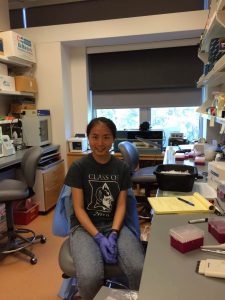8 weeks ago, I stood in the airport on the other side of the planet, alone, with a 50-pound suitcase. I was kind of depressed, not only because I would again be 8300 miles away (I actually looked this number up) from home for 6 straight months, but also because I was nervous about the summer. I have to admit that Duke has been quite a stressful and challenging place to be in the past year, and I was not sure what this summer had held for me. Two parts of me kept debating: “You will be fine! You’ve had experience working in a lab before.” “I know, but it’s a totally different lab this time. I’ll have to build new relationships with people, and learn from scratch about the research my new lab is doing.” “Yeah, it takes time, but eventually you will feel as comfortable as you are in your old lab.” “What if I don’t understand the science? What if I don’t know how to present my work to other people? What if I just somehow screw up?”… Anyway, me at the airport had no idea how these 8 weeks were going to be, which, me sitting at my bench now, can tell her, the past 8 weeks have been absolutely the most relaxing and rewarding experience she has ever had.
My project itself was very interesting – I’ve always wanted to work on human biology, and my project involved looking at human genetic diseases with human DNA samples. It’s been much of an excitement for me to simply hold the box of DNA samples labelled “Bipolar DNA samples – NIMH” in my hand, not to mention the awe that struck me when I was actually looking at the sequencing results. I feel like I am delving into the cryptic codes that constitute of our bodies and minds, although I know they are too exquisitely designed to be fully deciphered. But through the experience this summer, I’ve become more certain of my interest in genetics. The more complicated genetics is, the more rewarding it is to be part of the “deciphering squad”. So I will definitely be looking for more opportunities to learn about this field after the summer.
Other than my project itself, I’ve also found doing research a very amazing and relaxing lifestyle. Of course, it’s fun when experiments work and you get data. However, even though experiments fail 99% of the time, I still revel in the process of troubleshooting. Sometimes after a long day in lab, I was looking up literatures related to my project. I would suddenly somehow get inspired and come up with a new idea that might improve the outcome of my experiment. And then I really became that “crazy scientist”, wishing that I could go in lab right away and try it out, if only I had after-hour access to my lab. Other times, I got my sequencing results back at night. Occasionally, just browsing through them, I would have a big discovery (aka a heterozygous mutation), and I again became very excited. I would send a screenshot to my mentor immediately, even though I knew he would not check email until the next morning. Life as a researcher involves lots of “moments of truth”. For instance, when you are looking at a gel for the first time through the little glass window on top of the UV gel reader, or after doing a bacterial transformation, when you are taking the plates out of the incubator the next morning. It’s just those little moments of taking a deep breath, praying “please work”, and then exclaiming “oh my god it worked!”, that always make my day. Working in a lab everyday means that I always have something to be looking forward to, whether it be getting the results from yesterday’s PCR, or just giving myself a little pep talk like “okay, I’m going to redo this experiment, and it is going to work this time.” and this is what I find absolutely amazing and enjoyable about doing research.
Of course, I will still keep my options open and keep exploring other career paths. But looking back, I feel extremely fortunate and grateful to have participated in the BSURF program during this summer. It has really created a stress-free environment for me to figure out if I truly like doing research, and to occasionally have the feeling flash on me that, oh, I’m actually doing great things.

